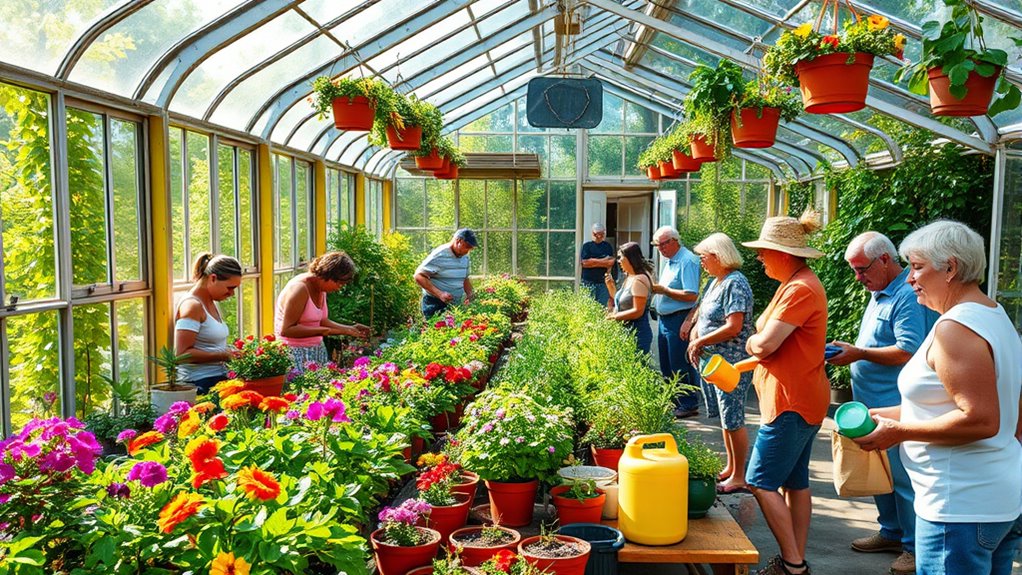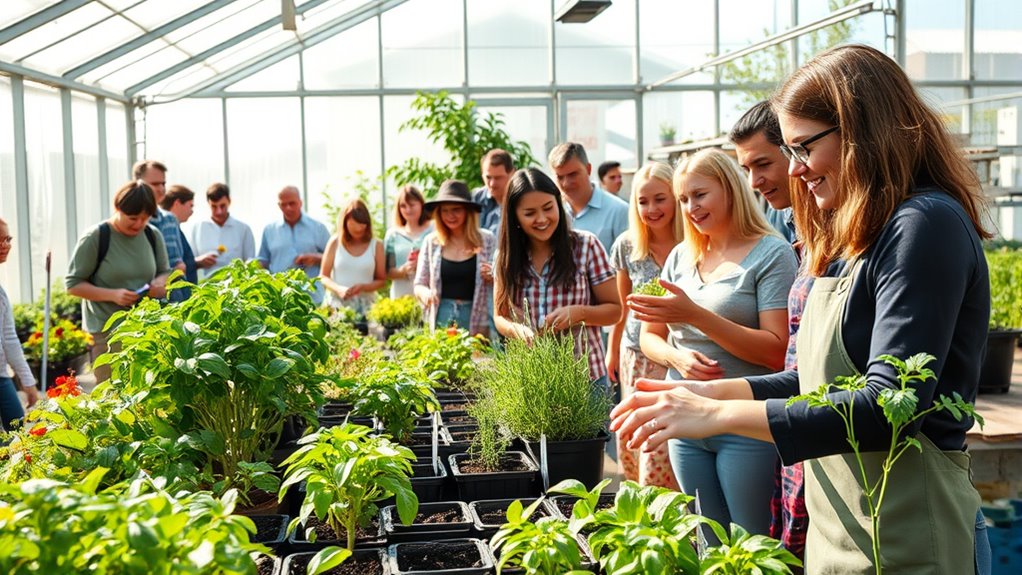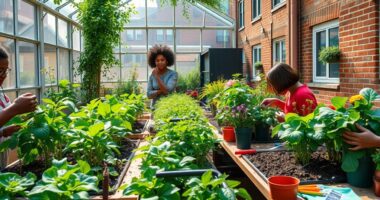Starting a greenhouse club in your community is a great way to bring neighbors together around gardening and sustainability. You can organize activities like plant propagation, composting workshops, and seasonal events to encourage skill-building and resource sharing. Creating shared spaces, a resource library, and engaging activities helps foster collaboration and environmental awareness. If you want to learn more about launching a successful green space that unites your community, keep exploring how to get started.
Key Takeaways
- Gather community interest and form a core group of gardening enthusiasts.
- Secure a suitable space, such as a community garden or vacant lot, for the greenhouse.
- Develop a plan including goals, activities like propagation and composting, and resource needs.
- Promote the club through local events, social media, and partnerships with schools or organizations.
- Organize regular workshops, resource sharing, and community events to foster engagement and learning.

Starting a greenhouse club in your community is a great way to bring people together around a shared passion for gardening and sustainability. Whether you’re an experienced gardener or a complete beginner, forming a club allows members to learn from each other, share resources, and develop new skills. One of the most engaging activities you can introduce to your club is plant propagation. This process lets members grow new plants from seeds, cuttings, or other plant parts, making gardening more cost-effective and rewarding. Teaching propagation techniques helps members understand how plants reproduce naturally, and it encourages hands-on learning. You can organize workshops on how to root cuttings, grow plants from seed, or divide mature plants, giving everyone practical skills they can apply at home.
Start a community greenhouse club to share plant propagation skills and grow together sustainably.
Alongside plant propagation, another essential topic to focus on is composting techniques. Composting not only reduces waste but also creates nutrient-rich soil that boosts plant health. Introducing members to composting methods, like traditional bin composting or vermicomposting with worms, helps demystify the process and makes it accessible. You could set up a communal compost bin at your greenhouse and invite members to contribute organic waste, such as vegetable scraps, leaves, and grass clippings. Demonstrating how to layer materials, maintain proper moisture, and turn compost ensures everyone understands how to produce quality compost efficiently. Sharing tips on composting techniques also promotes sustainability within the community, reducing reliance on chemical fertilizers and encouraging eco-friendly practices.
Creating a sense of community around these activities makes your greenhouse club more engaging and educational. Regular meetings can feature demonstrations on plant propagation, where members practice taking cuttings or sowing seeds, and composting workshops to teach proper bin management. Encouraging members to bring their own plant cuttings or compost ingredients fosters collaboration and resource sharing. As trust builds, members will feel more comfortable experimenting with new techniques, which can lead to successful plant growth and healthier gardens. Incorporating vertical storage solutions can further enhance organization, allowing members to maximize space and access tools easily during activities.
To ensure your club thrives, consider establishing a library of gardening resources, including guides on propagation and composting, and create a space where members can exchange tips and experiences. Organize seasonal events like plant swaps or composting challenges to keep members motivated and involved. By focusing on these foundational gardening skills, you’ll help cultivate a knowledgeable, environmentally conscious community that enjoys gardening as a sustainable, fulfilling activity. Starting your greenhouse club with a focus on plant propagation and composting techniques creates a strong base for growth, learning, and shared success.
Frequently Asked Questions
What Grants or Funding Options Are Available for Greenhouse Clubs?
You can explore solar grants and community funding options to support your greenhouse club. Local government programs often provide grants for sustainable projects, including solar energy initiatives. Additionally, seek out community funding through local nonprofits, environmental organizations, or crowdfunding platforms. These sources can help cover costs for greenhouse supplies, solar equipment, and educational activities, making it easier for your club to grow and succeed.
How Can I Recruit Diverse Community Members to Join?
You can recruit diverse community members by focusing on community outreach and emphasizing cultural inclusion. Attend local events, partner with multicultural organizations, and use multilingual materials to reach different groups. Invite local leaders to promote your greenhouse club, and create inclusive activities that celebrate various cultures. By actively engaging with diverse communities and highlighting the benefits of gardening for everyone, you’ll encourage more people from all backgrounds to join and participate.
What Safety Precautions Are Necessary for Greenhouse Activities?
Your greenhouse is a tiny jungle, so safety is vital. You should wear protective gear like gloves and goggles to prevent hazards. Keep a fire extinguisher nearby and guarantee proper ventilation to avoid respiratory issues. Regularly check for electrical hazards and slippery surfaces. Emergency preparedness includes having a first aid kit and clear evacuation routes. These steps help you prevent hazards and respond swiftly to emergencies, keeping everyone safe and thriving.
How Do I Choose the Best Location for the Greenhouse?
You should pick a location with ample sunlight, ideally 6-8 hours daily, to support healthy plant growth. Look for a spot with good drainage, protection from strong winds, and easy access to water. Consider urban gardening spaces that are open and unobstructed, maximizing sunlight exposure. Avoid shaded or congested areas, and check local regulations before setting up your greenhouse to guarantee it fits well within your community.
What Are the Best Ways to Promote the Club Locally?
The early bird catches the worm, so start promoting your Greenhouse Club now. Use local advertising like flyers, social media, and community bulletin boards to reach residents. Partner with local schools, businesses, and community centers to boost visibility and gain support. Attend community events and give demos to spark interest. These efforts can turn your club into a thriving, green-thumbed hub, making your efforts truly blossom.
Conclusion
Starting a greenhouse club is like planting seeds of hope and growth in your community. As you nurture young plants, you’re cultivating a future where collaboration and care blossom. Your efforts become a greenhouse—a symbol of resilience and renewal—showing that with passion and teamwork, everyone can thrive. So, take that first step and watch your community flourish, just like the vibrant life blossoming within your very own greenhouse.









